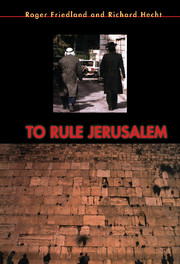Book contents
- Frontmatter
- Contents
- List of Illustrations
- Preface
- Acknowledgments
- Introduction
- 1 A Fearful Fusion
- Part I The Two Zions: Jews Against Zionism in Jerusalem
- 2 Zion Against Zionism
- 3 Black Zion
- 4 Sabbath Wars
- 5 To Control the Center
- Part II Zion Divine: Jerusalem as the Messianic Central City
- Part III Birth of a Nation
- Part IV Heart of Stone
- Notes
- Index
3 - Black Zion
Published online by Cambridge University Press: 13 May 2010
- Frontmatter
- Contents
- List of Illustrations
- Preface
- Acknowledgments
- Introduction
- 1 A Fearful Fusion
- Part I The Two Zions: Jews Against Zionism in Jerusalem
- 2 Zion Against Zionism
- 3 Black Zion
- 4 Sabbath Wars
- 5 To Control the Center
- Part II Zion Divine: Jerusalem as the Messianic Central City
- Part III Birth of a Nation
- Part IV Heart of Stone
- Notes
- Index
Summary
To an outsider Mea She'arim, the haredi center, appears dark and undifferentiated. “Black crow people,” Yehuda Amichai, the Israeli poet, calls its residents, all clothed in black. Given how threatened the haredim feel, one might imagine them solidary and united, densely packed into a few neighborhoods, all dedicated to preserving the traditions of their forefathers against Jewish modernity down at the corner. But, in fact, this community of those who have never fully made their peace with Zionism is still deeply divided between rabbis and rebbes, between Ashkenazim and Sephardim, between those who look to their religious leaders for privileges garnered from an alien Zionist state and those who demand their rights as its citizens. The community is rife with internal discord and mutual suspicion, a fertile ground for new political forces.
The Pious Ones
The most explosive cleavage within the haredi community, between hasidim and mitnagdim, first emerged among Eastern European Jewry in the eighteenth century. This division, between those who seek God's spirit and those who read his words, shattered the Jewish communities of Russia and the Polish lands. To understand it, we must return to the Sephardi Jews who trickled into Safed and Jerusalem in the fifteenth and sixteenth centuries.
The Spanish and Portuguese Jews who migrated to Palestine imported the intellectual wealth of the Iberian peninsula with them. Long before their exile, the Sephardim had developed a rich mystical tradition called the Kabbalah.
- Type
- Chapter
- Information
- To Rule Jerusalem , pp. 68 - 92Publisher: Cambridge University PressPrint publication year: 1996

